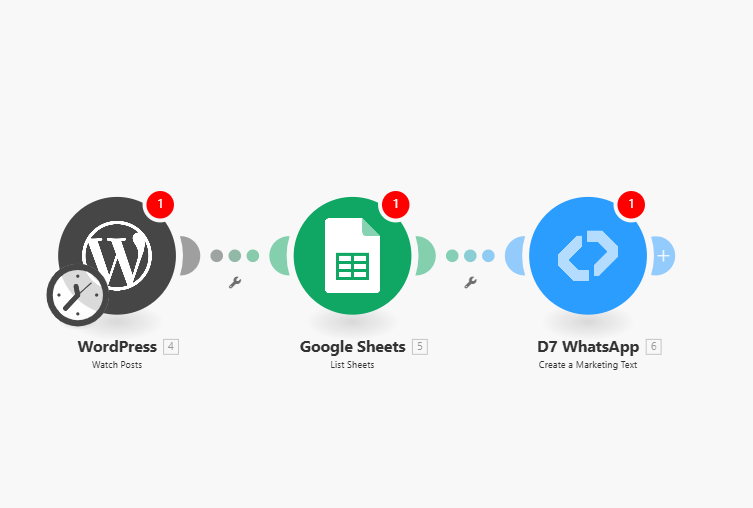Turn WordPress “New Post Published” updates into WhatsApp alerts
Your audience is on WhatsApp. The moment a post goes live, this Make + D7 workflow instantly notifies subscribers with a clean, branded message—so your content gets seen, clicked, and shared while it’s still fresh.

What this workflow does
- Watch your WordPress site for a new post
- Builds a WhatsApp-ready alert (title, excerpt, link, optional image)
- Broadcast it to your opted-in subscribers via D7 WhatsApp API
- Tracks delivery, replies, and opt-outs—so you can refine over time
Automation Blueprint
1) Trigger
- WordPress: “New Post Published.” Captures post title, permalink, excerpt, author, categories, and featured image.
2) Prepare the message
- Pick a D7-approved WhatsApp template (e.g., Post_Alert).
- Map variables: {{site_name}}, {{post_title}}, {{short_excerpt}}, {{cta_link}}.
- Optional: add UTM parameters to the link for analytics.
3) Get your audience
- Pull an opted-in subscriber list from Google Sheets, Airtable, a CRM, or a Make Data Store (include name, phone, language, segments).
- Filter by segment (e.g., “blog_updates = true” or “category = WordPress”).
4) Deliver at scale
- Iterate subscribers and send a D7 WhatsApp template message per contact.
- Add flow control for throughput (Make’s Queue/Sleep/Iterator) to respect rate limits and ensure steady delivery.
- Log success/failures; route errors to Slack or email.
5) Handle replies and statuses
- Use D7 webhooks to capture delivery/read receipts, failures, and incoming replies.
- Update your subscriber store with last-contacted time, opt-out keywords, and preferences.
6) Optional digest mode
- Instead of instant alerts, buffer posts for a daily/weekly digest.
- Aggregate post titles + links, then send one compact WhatsApp message at your chosen time.
Why D7 WhatsApp API
- Pre-approved templates: Send compliant, branded messages that land reliably—even outside the 24-hour session window.
- Two-way messaging: Let readers reply with questions, keywords, or category preferences; route conversations to agents or automated flows.
- Fast, reliable delivery: High deliverability with real-time delivery and read receipts to measure impact instantly.
- Media support: Enrich messages with images, documents, and buttons for a more clickable experience.
- Webhooks + analytics: Full visibility into message status and engagement for smarter optimization.
- Global-ready: Scale from local audiences to international subscribers with robust routing and compliance tooling.
Developer Tips
- Start with a staging template: Create a “Post Alert (Staging)” template, test on internal numbers, then clone for production.
- Validate phone numbers: Normalize to E.164 format and pre-verify in your data store to reduce failures.
- Segment early: Store subscriber categories (e.g., “Dev,” “Marketing,” “News”) and only notify the right segments to protect template quality.
- Respect opt-ins and opt-outs: Capture consent on-site. Support keywords like STOP/UNSUBSCRIBE and sync status back to your list.
- Rate limiting and retries: Use Make’s Sleep/Iterator/Queue modules; add exponential backoff on transient errors; retry failed sends.
- Observability: Log every send with post_id, subscriber_id, template_id, and status; build a simple dashboard (Sheets/Airtable/Data Store + charting).
- Link hygiene: Append UTM tags (utm_source=whatsapp&utm_medium=make&utm_campaign=post_alert) to track WhatsApp-driven traffic in analytics.
- Fallbacks: If WhatsApp fails for a contact, optionally route to SMS or email to maintain reach.
- Digest bundling: For high-post-volume sites, batch multiple posts into one template to reduce noise and costs.
- Security: Keep D7 API keys in Make’s Connection/Secrets; never hardcode. Limit webhook exposure with secret tokens and IP allowlisting.
